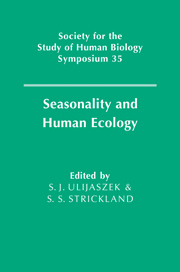Book contents
- Frontmatter
- Contents
- List of contributors
- Acknowledgements
- 1 Introduction
- 2 Seasonality and human biology
- 3 The influence of seasonality on hominid evolution
- 4 Environmental temperature and physiological function
- 5 Physiological responses to variations in daylength
- 6 Seasonality and fertility
- 7 Seasonality of reproductive performance in rural Gambia
- 8 Seasonal effects on physical growth and development
- 9 Seasonal variation in the birth prevalence of polygenic multifactorial diseases
- 10 Environment, season and infection
- 11 Seasonal mortality in the elderly
- 12 Nutritional seasonality: the dimensions of the problem
- 13 Seasonal variation in nutritional status of adults and children in rural Senegal
- 14 Culture, seasons and stress in two traditional African cultures (Massa and Mussey)
- 15 Agriculture, modernisation and seasonality
- 16 Seasonal organisation of work patterns
- Index
7 - Seasonality of reproductive performance in rural Gambia
Published online by Cambridge University Press: 23 January 2010
- Frontmatter
- Contents
- List of contributors
- Acknowledgements
- 1 Introduction
- 2 Seasonality and human biology
- 3 The influence of seasonality on hominid evolution
- 4 Environmental temperature and physiological function
- 5 Physiological responses to variations in daylength
- 6 Seasonality and fertility
- 7 Seasonality of reproductive performance in rural Gambia
- 8 Seasonal effects on physical growth and development
- 9 Seasonal variation in the birth prevalence of polygenic multifactorial diseases
- 10 Environment, season and infection
- 11 Seasonal mortality in the elderly
- 12 Nutritional seasonality: the dimensions of the problem
- 13 Seasonal variation in nutritional status of adults and children in rural Senegal
- 14 Culture, seasons and stress in two traditional African cultures (Massa and Mussey)
- 15 Agriculture, modernisation and seasonality
- 16 Seasonal organisation of work patterns
- Index
Summary
Introduction
There are a number of ways in which the reproductive performance of women can be assessed. These include measures of fertility, pregnancy outcome (one expression of which is birth weight), lactational performance, and child mortality. Ultimately, the survival to reproductive age of as many children as possible is the most direct measure of successful reproductive performance, the other variables, including pregnancy outcome and lactational performance, being proximate factors.
Although it is acknowledged that social factors can influence fertility, these will not be addressed in this chapter. Rather, the focus is on seasonal variation in a number of factors that can cause physiological stress in women and young children. Such factors are linked to seasonality in the natural human-created agricultural environment, and for analytical purposes, can be reduced to the following: 1. food availability and intake of dietary energy; 2. energy expenditure (and also how these two factors affect energy balance); and 3. infectious disease, as it influences pregnancy outcome and child survivorship. Although it might be argued that energy balance (that is, the difference between intake and expenditure) is of prime consideration with respect to energy nutritional stress, a good case has been put forward to suggest that energy intake, expenditure (insofar as this is an expression of heavy physical activity) and balance should be considered separately in at least one aspect of reproductive performance, fertility (Rosetta, 1990). The relative importance for reproductive performance of seasonal variation in these three factors will be considered for one rural agricultural system in the Gambia.
- Type
- Chapter
- Information
- Seasonality and Human Ecology , pp. 76 - 88Publisher: Cambridge University PressPrint publication year: 1993
- 2
- Cited by

